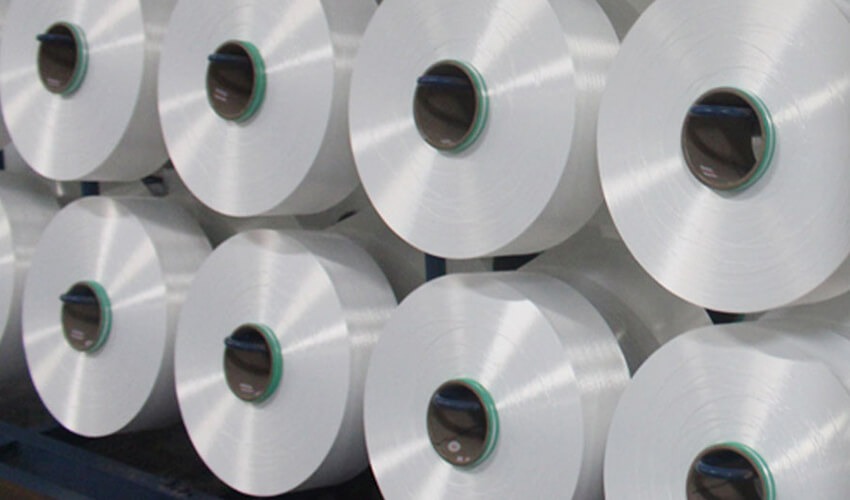Spandex, Lycra or Elastane is a synthetic fiber known for its exceptional elasticity. It is stronger and more elastic than natural rubber. It is a polyester-polyurethane copolymer that was invented in 1958 by chemist Joseph Shivers at DuPont’s Benger Laboratory in Waynesboro, Virginia. It was introduced in 1962 and revolutionized the clothing industry in many ways.
The name “spandex” is an anagram of the word “expands”. It is the preferred name in North America; in continental Europe it is referred to by variants of “elastane”, i.e. elasthanne (France), elastan (Germany), elastano (Spain), elastam (Italy) and Elasthaan (Netherlands), and is known in the UK, Ireland, Portugal, Brazil, Argentina, Australia, New Zealand and Israel primarily as Lycra.
Spandex yarn is a classification of man-made fibers, described in technical terms as segmented polyurethane, which consists of 85% of polyurethane polymer segments. The main raw materials of spandex yarn are PTMEG and MDI.
Spandex yarn can be stretched four to seven times its original length, but will spring back to its original length once the tension is released. Although spandex fiber looks like a continuous thread, it is actually a bunch of filaments. It is composed of “soft” and flexible sections combined with “hard” or rigid sections. This gives the fiber inherent long-lasting elasticity.
Spandex yarn is widely used in,
• Casual Wear
• Sportswear, Swim Wear, Body suits etc.,
• Innerwear, jump suits, lingerie accessories etc.,
• Socks, Hosiery, Glove, etc.
• Elastic Lace, Elastic Tapes.
• Medical products, Wrist support, Knee pad and Elastic bandages, etc.
• Elastic thin fabrics, Shirt, Skirts, Suits, Gauze, etc.
• Woolen Sweater, Denim Apparels.
• Medical & Hygiene Textiles.
• Automotive Interiors, Seat Belts, etc.
SPANDEX COVERED YARN
When spandex as the core in the percentage from 5% to 20%, is wrapped with various yarns and fibers such as nylon, polyester, etc for the end-product, what we get is a Spandex Covered Yarn. This is to increase the filament yarns with higher elasticity and construct textile fabrics for better draping property and keeping in shape for the end-products. It draws better properties than rubber yarn in intensity, stress, hard-wearing, ageing-resistant on the basis of chemical research. Elastic or Spandex covered yarn furnishes fabric with elasticity which is different from traditional fabric in the sense of touch and external factors. Spandex Covered Yarn is widely used for woven and knitted fabrics ,textile – weaving, warp-weaving, knitting, underwear, pantyhose ,socks, garments, and medical uses.
Spandex Covered Yarns are divided into two types – Conventional Covering Yarn [traditional covering] & Air-Jet Covered / Intermingled Yarn.
Conventional Covered Yarn [CCY]
The conventional covering process can be defined as the traditional method of manufacturing covered yarns. Wrapping hard filament yarn around extend spandex fiber or rubber. In this process, the spandex fibre is drawn at a constant factor and is continuously fed through a hollow spindle and covered with a covering yarn from a flanged bobbin. The elongation, elasticity and look of the yarn depends on 3 factors, defined parameter of the draft, turns per metre and the covering yarn selected for the process.
Application for these yarn are in the fashion sector for hosiery, bodies and seamless articles as they give the finished product a transparent look, outstanding durability and a smooth appearance with a luxurious touch.
- Single Covered Yarn [SCY] – When spandex is warped with one filament yarn it is called Single Covered Yarn. Hold Spandex fiber as center core, then warp one yarn in S twisted [ant –clockwise] way or Z twisted [clockwise] way around extend spandex fiber outer layer. Socks and underwear yarns use both S and Z according to the body structure of characters.
- Double Covered Yarn [DCY] – When spandex is warped with two filament yarns in opposite directions we get Double Covered Yarn. Holding spandex fiber as the centre core, then wrapping two hard yarn on the lower and upper levels in mutually inverse way(S- twisted and Z-twisted) around extend spandex fiber outer layer gives DCY.
Air-Jet Covered/Intermingled Yarn [ACY]
The centre core spandex is covered by a multi-filament artificial yarn by air jets to manufacture Air Covered Yarns. In this process, the elastic yarn is intermingled with a filament yarn such as nylon or polyester using compressed air and wound straight onto the yarn spool. Therefore, the air-covered yarns have a powdery look and an exceptional softness. But the spandex protection is less in ACY when compared to CCY, however the productivity is high than compared to CCY.
For the warp in weaving, air-covered yarns undergo an additional working step on a two-for-one twisting machine which means that the sizing process can be omitted. Hard twisting result in improved strength and evenness, giving the final product a smoother surface.
Benlon India is producing a vast range of Air Covered Yarn ranging from 100 DN – 2500 DN .
Fine yarn of 100 DN is being used in sarees in Southern part of India like Bangalore, Salem and also in Varanasi and Mau (U.P). Rest from 300 – 2500 DN yarn is used in furnishing industry for curtains, bed covers, car seat covers and furnishing fabrics.
Spandex Covered Yarn Application
| Spandex Covered Yarn | Applications | Pros on Fabrics | Cons on Fabrics |
| Single Covered Yarn(SCY) |
|
|
|
| Double Covered Yarn(DCY) |
|
|
|
| Air Covered Yarn(ACY) |
|
|
If you are interested in our products and would like to be part of our growth story, please contact us on info@chinausmile.com or Whatsapp: +86-13923938088
For more information about our company and our products, please visit https://chinausmile.com/

